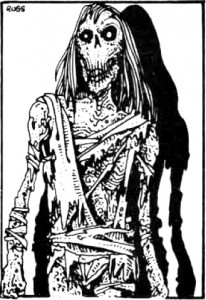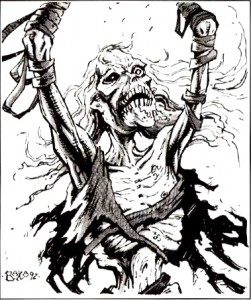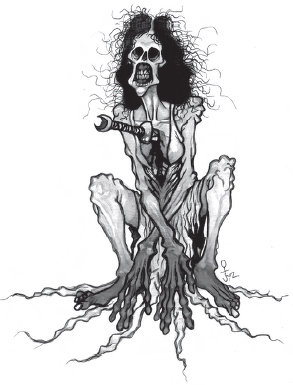Archive for the ‘Classic Monsters’ Category
Classic Monsters: Coffer Corpse
May 25, 2012Note: ‘Classic’ is a pretty subjective term, when I use it here I mean to say: monsters that have survived through the editions of D&D that I think are cool. In this series of articles I look at the development of a classic monster over time and try to add a ‘crunchy’ piece of my own to the creature’s canon.
I’m posting this second  installment of Classic Monsters as part of The Going Last Gaming Podcast’s May of the Dead blog carnival. There has been a shameful shortage of undead on Ménage à Monster, and the blog carnival seemed like the perfect opportunity to rectify that (and a great excuse to write another article in this series – the eye of the deep was getting pretty lonely).
installment of Classic Monsters as part of The Going Last Gaming Podcast’s May of the Dead blog carnival. There has been a shameful shortage of undead on Ménage à Monster, and the blog carnival seemed like the perfect opportunity to rectify that (and a great excuse to write another article in this series – the eye of the deep was getting pretty lonely).
I first encountered the coffer corpse lurking in the pages of the Fiend Folio and was instantly drawn to the fantastic Russ Nicholson illustration (click on the images to view full size). While the coffer corpse doesn’t get the same kind of fan recognition as the death knight (also introduced in Fiend Folio), I’ve always felt its low power level and unique mechanics gave it a certain charm. Like the Monster Manual’s vampire and mummy, the coffer corpse was also one of the few undead creatures in the game whose background jived with the mythology of the restless dead in horror films. While arguably a little obscure, the coffer corpse’s great mechanics, art and story combine to make the monster a classic.
Origins
 Like many of the monsters in the Fiend Folio, the coffer corpse first saw print in the pages of White Dwarf as part of the ongoing Fiend Factory column (issue 8, 1978). In its infancy White Dwarf was a general gaming magazine with a focus on D&D, which makes sense given that Games Workshop (the company that produces the magazine) was at that time the UK distributer of the D&D game. Since the AD&D Monster Manual had only just been published in the UK, the creatures in the Fiend Factory column were created for the OD&D game.
Like many of the monsters in the Fiend Folio, the coffer corpse first saw print in the pages of White Dwarf as part of the ongoing Fiend Factory column (issue 8, 1978). In its infancy White Dwarf was a general gaming magazine with a focus on D&D, which makes sense given that Games Workshop (the company that produces the magazine) was at that time the UK distributer of the D&D game. Since the AD&D Monster Manual had only just been published in the UK, the creatures in the Fiend Factory column were created for the OD&D game.
The White Dwarf version of the coffer corpse sets out the parameters for all of the incarnations of the monster to follow. Cursed to undeath by incomplete or botched funeral rites (or as the author puts it, when a corpse fails to return to its ‘maker’), these animate corpses are often found floating on waylaid grave barges. The coffer corpse attacks by choking the life out of its victims, and can only be harmed by magic weapons (which inflict half damage). If the creature is struck with a normal weapon, it falls to the ground, apparently destroyed, only to rise up a round later in a display so horrible NPCs must succeed at a save vs. fear or flee in terror (the editor, Don Turnbull, notes at the end of the entry that this is probably an error and that PCs should also have to save vs. fear as well).
The coffer corpse was created by Simon Eaton, a name I’m not familiar with, as the only other credit I can find attributed to him is the witherweed (also featured in the Fiend Folio).
1st Edition
The coffer corpse was given an AD&D makeover for its inclusion in the Fiend Folio (and D&D canon). Its origins remained unchanged but a few of the monsters abilities were tweaked. Magic weapons do full damage to this version of the coffer corpse, and it falls to the ground if it is hit for 6 or more points of mundane weapon damage (instead of the ambiguous “if struck on the head” of the previous version). When the coffer corpse reanimates, all who are in melee must save vs. fear, not just NPCs. Additionally, the strangulation attack of the coffer corpse is upgraded from a simple 1d6 attack to one that inflicts automatic constriction damage each round, which is especially deadly since “nothing will release the grasp of the coffer corpse once it has locked its hands in place.”
2nd Edition
The coffer corpse next appears in 2e’s Fiend Folio Appendix for the Monstrous Compendium. While generally identical to its 1e incarnation, most of its abilities are expanded and explored in greater detail: this coffer corpse has resistance to some weapon types (magic slashing weapons inflict normal damage with no bonus, blunt weapons inflict full damage and piercing weapons inflict half damage), and it is possible to break free of its strangling grip (but with a strength of 20 it’s still very difficult).
The most important addition to the coffer corpse in 2e is an attempt to utilize the creature’s origins as a way for clever players to defeat it: “If the unfinished death ritual which binds the coffer corpse to undeath can be completed, the creature will be released and effectively destroyed.” The mechanics of how players might go about discovering and acting on this information is left to the DM’s discretion (and this bit is buried in the habitat/society section of the write-up), which is too bad since I think this is where the coffer corpse’s true potential as a classic monster lies.
3rd Edition
The coffer corpse never saw an official release for 3e. The Fiend Folio is generally regarded as a mixed bag and, in an effort to excise some of D&D’s sillier monsters from the game (the flumph is almost a clichéd example), many great monsters from this book, including the coffer corpse, were not updated for this edition of the game. However, Necromancer Games included the coffer corpse in their Tome of Horrors book, which updated just about every monster from 1e that WOTC had left behind (an admirable effort – though I think the carbuncle should have been abandoned to the dustbin of history). This version is more or less a direct translation of the coffer corpse from the Fiend Folio for 3e rules (damage reduction instead of immunity to normal weapons, and standard grab and constrict rules for the coffer corpse’s strangulation). It is a solid adaptation but, by sticking so closely to its 1e incarnation, I think it was a missed opportunity to expand and clarify the ‘unfinished funeral rite’ that the 2e version touched on (also, why they maintained the 25% chance for the coffer corpse to wield a weapon from previous editions is a mystery to me – the fact that the monster strangles people to death is what makes it interesting).
4th Edition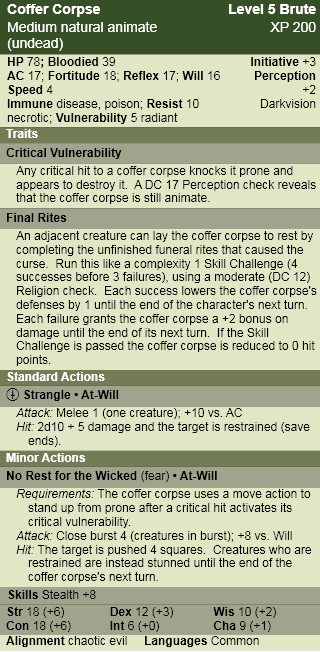
Not having a memorable appearance in 3e, and with 4e’s proliferation of low level skeleton and zombie breeds, it is hardly surprising the coffer corpse is absent from this edition. I do think that 4e’s skill challenge mechanic is particularly well suited to simulate the pitched struggle of a Cleric trying to complete funeral rites while the undead monster strangles her companion, which makes the coffer corpse the perfect candidate for entry into 4e’s canon.
Coffer Corpse
Barred entry into the afterlife by incomplete funeral rites, the coffer corpse is cursed to a restless eternity, its only desire to squeeze the hated spark of life from anything that crosses its path.
Lore
Religion DC 15: Although they superficially resemble zombies, coffer corpses aren’t animated through necromantic rituals, but are created as a result of a divine curse. Their deathlike grip is exceptionally strong, making escape all but impossible once the coffer corpse has wrapped its bony fingers around your throat.
Religion DC 20: Cursed by an incomplete funeral ritual, a coffer corpse is difficult to destroy, often springing back to life only moments after being felled. Only by completing the creature’s burial rites can the curse be lifted and the tortured soul granted peace.
Encounters
Coffer corpses can be encountered floating aimlessly in a waylaid funeral barge, slumped over a half dug grave, or lying in a coffin awaiting the completion of an interment ritual that never comes to pass. They are often part of a group of undead, created as part of the larger tragedy that interrupted the creature’s funeral.
Coffer Corpses in Combat
Every moment of existence is torture for a coffer corpse, so these undead monsters fight without regard for their own well-being. Even as they strangle and destroy they often liplessly whisper for release in their victim’s ear.
Pathfinder
For those looking for a classic interpretation of the coffer corpse, Necromancer Games has updated their 3e book Tome of Horrors Complete, and the coffer corpse, for the Pathfinder game (and since its part of the OGL you can get this version at the Pathfinder System Resource Document). If you like the ideas in my 4e version of the monster though, I have used it as the blueprint for this Pathfinder translation of the coffer corpse that builds on the creature’s 2e presentation. The flavour text and lore from the 4e monster are system neutral enough to be used as is.
Classic Monsters: Eye of the Deep
May 13, 2011Note: ‘Classic’ is a pretty subjective term, and when I use it here I mean to say: monsters that have survived through the editions of D&D that I think are cool. In this series of articles I look at the development of a classic monster over time and try to add a ‘crunchy’ piece of my own to the creature’s canon.
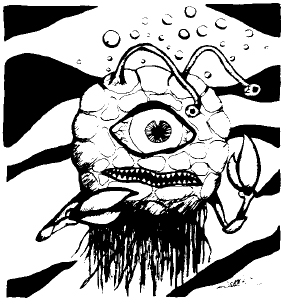 The eye of the deep, the beholder’s unloved cousin, has long held a special fascination for me. As I’ve mentioned previously, when I was a kid who didn’t know any better, flipping through my older brother’s copy of the Monster Manual, this critter caught my eye. Until I had been playing the game for some time, I mistakenly believed that the eye of the deep was a more powerful version of the beholder, since it had eye rays and giant lobster claws (lobster claws were the tentacles of the eighties). Even when I had been properly schooled in D&D lore, my initial impressions of this monster insured it would regularly surface from my subconscious any time I found myself staring down into water that was too deep to see the bottom (well, the eye of the deep and those giant tube worms from the G.I. Joe episodes with the MASS device).
The eye of the deep, the beholder’s unloved cousin, has long held a special fascination for me. As I’ve mentioned previously, when I was a kid who didn’t know any better, flipping through my older brother’s copy of the Monster Manual, this critter caught my eye. Until I had been playing the game for some time, I mistakenly believed that the eye of the deep was a more powerful version of the beholder, since it had eye rays and giant lobster claws (lobster claws were the tentacles of the eighties). Even when I had been properly schooled in D&D lore, my initial impressions of this monster insured it would regularly surface from my subconscious any time I found myself staring down into water that was too deep to see the bottom (well, the eye of the deep and those giant tube worms from the G.I. Joe episodes with the MASS device).
I admit, I’ve never used the eye of the deep in a game. I’m not really sure why. It could have been because I’ve never ran a game that focused on water encounters. Or it could be because(as far as I’m aware), the eye of the deep was never used in a single published adventure, not even in 2nd edition’s monstrous arcana series focused on beholders and beholder-kin (Eye of Pain, Eye of Doom, and Eye to Eye). Then again, it took until 3.5 edition for me to use a regular beholder in an encounter (and no one would argue with its icon status), so I hardly think that’s a strike against it.
Possible Origins?
This is a bit of a non sequitur in an already long article, but I’ve always wondered if the character of Alpha Centauri from Doctor Who had anything to do with the inspiration for the eye of the deep. It does resemble the creature, and it did air in the Curse of Peladon serial in 1972, 5 years before the eye’s appearance in D&D.
1st Edition
While the beholder made its debut in the pages of the Greyhawk supplement for OD&D, the eye of the deep didn’t make it into the game until 1977’s Monster Manual. It has the distinction of being the very first in a long line of beholder variants the game acquired over the years. The book establishes the eye of the deep as a 3-5 foot diameter sphere (size large in AD&D), with a pair of crab-like pincers, a large central eye and a pair of eyestalks. The main eye can emit a blinding flash that stuns opponents, while the smaller eyes can work together to create illusions or cast hold monster and hold person independently.
In Dragon Magazine’s The Ecology of the Eye of the Deep, none other than Ed Greenwood expands on the creature’s lore. The meat of the article describes the creature’s reproductive cycle (they’re hermaphrodites), its hunting habits (it uses its illusion powers to lure prey close and then stuns them with its central eye), and even scientific tidbits about its physiology (the eye of the deep cannot rise to the surface without the change in pressure causing it to explode). Greenwood also adds to the eye of the deep’s attacks, giving it the ability to grab onto opponents with its claws.
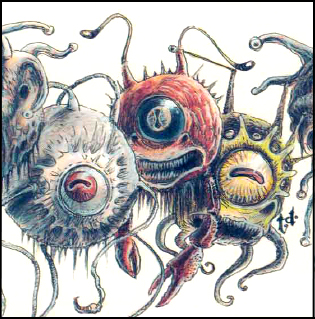 2nd Edition
2nd Edition
The eye of the deep next appears in 2nd edition D&D’s first volume of the Monstrous Compendium. Here it is presented as a variant of the beholder, but is otherwise almost identical to its AD&D version (although its size remains 3-5 feet in diameter, in this version of the game that makes it a small-medium size creature). Ed Greenwood’s grasping claw attack is not incorporated into the monster’s statistic block.
Late in the edition’s lifespan we are given another glimpse of the eye of the deep in the monstrous arcana supplement, I Tyrant. Although the creature gets only a short paragraph in the book, author Aaron Allston gives us a glimpse of the eye of the deep’s sociology: they communicate over long distances using the light flash from their central eye, and teach their offspring how to hunt using their ability to generate illusions (although this doesn’t really fit with Greenwood’s depiction of them randomly leaving eggs on the sea floor).
3rd Edition
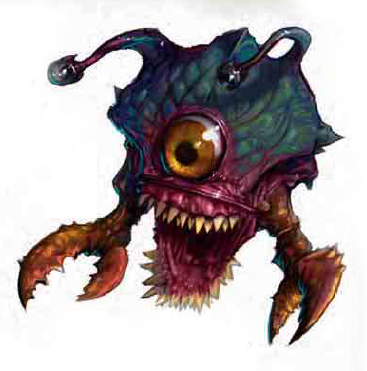 The eye of the deep isn’t updated until 3.5 edition’s Lords of Madness hardcover. In this incarnation the eye retains the ability to stun and blind with its central eye, hold monster, generate illusions, and even grab hold with its claws. It loses the ability to hold person (which makes sense since hold monster supersedes that ability in this edition), but gains the power to project a cone of cold. This edition also sees the first real size change in the creature, growing to a nine foot diameter, 6000 pound behemoth (large sized with the option to advance in hit dice to huge size).
The eye of the deep isn’t updated until 3.5 edition’s Lords of Madness hardcover. In this incarnation the eye retains the ability to stun and blind with its central eye, hold monster, generate illusions, and even grab hold with its claws. It loses the ability to hold person (which makes sense since hold monster supersedes that ability in this edition), but gains the power to project a cone of cold. This edition also sees the first real size change in the creature, growing to a nine foot diameter, 6000 pound behemoth (large sized with the option to advance in hit dice to huge size).
The behaviour of the eye of the deep generally conforms to previous editions (it uses illusions to lure and confuse prey), but the authors (Richard Baker, James Jacobs and Steven Winter) made one alteration that I think illustrates the changing philosophy of D&D game design. Instead of keeping a solitary vigil over shipwrecks at the bottom of the ocean (and exploding if it ascends), the Lords of Madness eye of the deep prefers to hunt on the surface. While this approach may be less realistic (we are talking about a giant floating eye with claws) than Greenwood’s, it’s a change that puts the monster in immediate and direct conflict with the PCs and thus makes it much more useful for DMs.
4th Edition
 It seems that the only legacy of this monster to penetrate the 4th edition of D&D has been the ‘eye of’ naming convention. Then again, the eye of the deep has not been singled out in its exclusion. It seems that the long list of beholder-kin from previous editions is one of the ‘sacred cows’ the designers of the game wished to slay. It seems though, that a long list of beholder variants isn’t what the designers had a problem with per se (the compendium currently holds 17 different variety of the monster). So I guess it was the specific variants themselves they didn’t like (some of them were pretty silly – I’m looking at you director)… Or maybe they just wanted to create something new. Regardless, I can’t let the snubbing of one of my favourite beasties stand, so I present to you this unofficial entry into 4th edition canon:
It seems that the only legacy of this monster to penetrate the 4th edition of D&D has been the ‘eye of’ naming convention. Then again, the eye of the deep has not been singled out in its exclusion. It seems that the long list of beholder-kin from previous editions is one of the ‘sacred cows’ the designers of the game wished to slay. It seems though, that a long list of beholder variants isn’t what the designers had a problem with per se (the compendium currently holds 17 different variety of the monster). So I guess it was the specific variants themselves they didn’t like (some of them were pretty silly – I’m looking at you director)… Or maybe they just wanted to create something new. Regardless, I can’t let the snubbing of one of my favourite beasties stand, so I present to you this unofficial entry into 4th edition canon:
Beholder Eye of the Deep
Not all beholders dwell in the twisted passages of the underdark. Some float in the lightless ocean depths, rising to the surface to terrorize and destroy any that dare cross their invisible territories.
Lore
Dungeoneering DC 15: Though they lack the sheer number of eye rays that other beholders possess, the eye of the deep compensates by way of strong grasping claws and the ability to generate illusions.
Encounters
Beholders are rarely willing to serve other creatures, and the eye of the deep is no exception. However, some eyes of the deep bully nearby sahuagin into servitude, using them as shock troops to subdue passing ships and coastal towns. The eye of the deep is a negligent master though, and over time the sahuagin invariably desert, fall in combat, or are eaten for food.
Eye of the Deep in Combat
The eye of the deep takes great pleasure in creating illusions to lure its prey in close. The cruel beasts create images of shipwreck survivors, mermaids, and anything else they think will draw their targets into the water. The eye of the deep always opens combat with a stunning blast of light from its central eye before ripping its helpless victim into digestible hunks with its claws.
